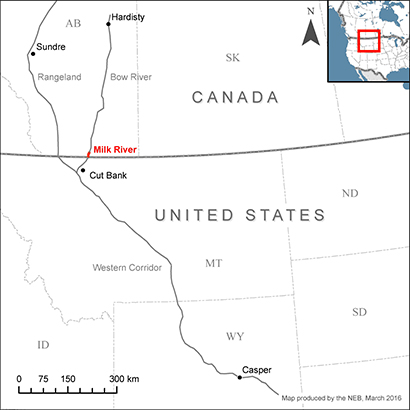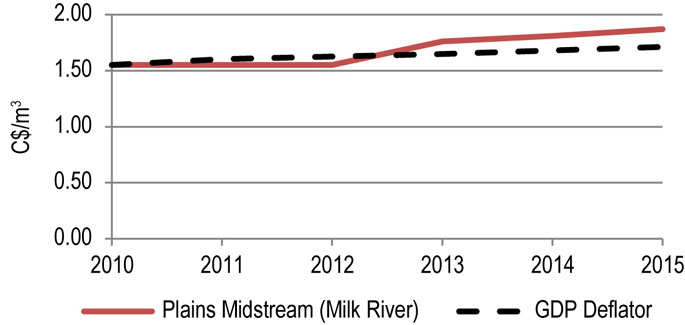Canada’s Pipeline Transportation System 2016
Plains Midstream Canada ULC – Milk River Pipeline’s Milk River Pipeline
| Commodity and NEB Group | Crude Oil (Group 2) |
| Average 2015 throughput | 15 087 m³/d (94.9 Mb/d) |
| Primary receipt points | Milk River, AB |
| Primary delivery points | Santa Rita Station, Glacier County, MT |
| Abandonment Cost Estimate and Collection PeriodNote a | $4.1 million; 40 years |
Overview
The Milk River Pipeline (Milk River) is a 16.5 km pipeline system that connects with the Bow River Pipeline at Milk River, AB. It transports a variety of crude oil streams to the Canada-U.S. border west of Coutts, AB and connects with the Cenex Santa Rita Pipeline System in the U.S. Milk River is owned by Plains Midstream Canada ULC (PMC).

Source: NEB
Text version of this map
This map provides an overview of the Milk River Pipeline System near the Alberta-Montana border.
Key Developments
In April 2012, Plains Midstream Canada ULC (PMC) submitted an application to the Board to replace the 10-inch pipeline between the Milk River Terminal south of Milk River, AB to the Canada-U.S. border. The Board approved the request on August 2012 (XO-P384-011-2012) and Leave to Open was granted in December 2012.
In October 2013, PMC filed with the Board an application to deactivate its 6-inch pipeline and other facilities that were no longer needed after the replacement of the 10-inch pipeline. The Board issued order MO-007-2014 on February 2014, granting the request.
Tolls
Figure 9.6.1 shows the Milk River benchmark toll (medium crude oil from the Milk River Pump Station to the U.S. border) and the GDP deflator (normalized) for 2010-15. Over this period, the benchmark toll has increased roughly in line with the GDP deflator. Milk River tolls are regulated on a complaint basis.
Figure 9.6.1: Milk River Benchmark Toll

Source: NEB
Text version of this graphic
This graph shows the Plains Midstream (Milk River) benchmark toll as a solid red line and the GDP deflator as a black dashed line. The toll remained steady between 2010 and 2012 and increased slightly between 2013 and 2015.
Financial
Milk River transportation revenues have increased due to toll increases.
| Milk River Pipeline | 2010 | 2011 | 2012 | 2013 | 2014 | 2015 |
|---|---|---|---|---|---|---|
| Transportation Revenues (millions) | $8.2 | $8.4 | $7.9 | $9.8 | $11.3 | $12.8 |
| Assets (millions) | $22.2 | $22.0 | $24.3 | $29.7 | $29.4 | $28.6 |

- Date modified:
